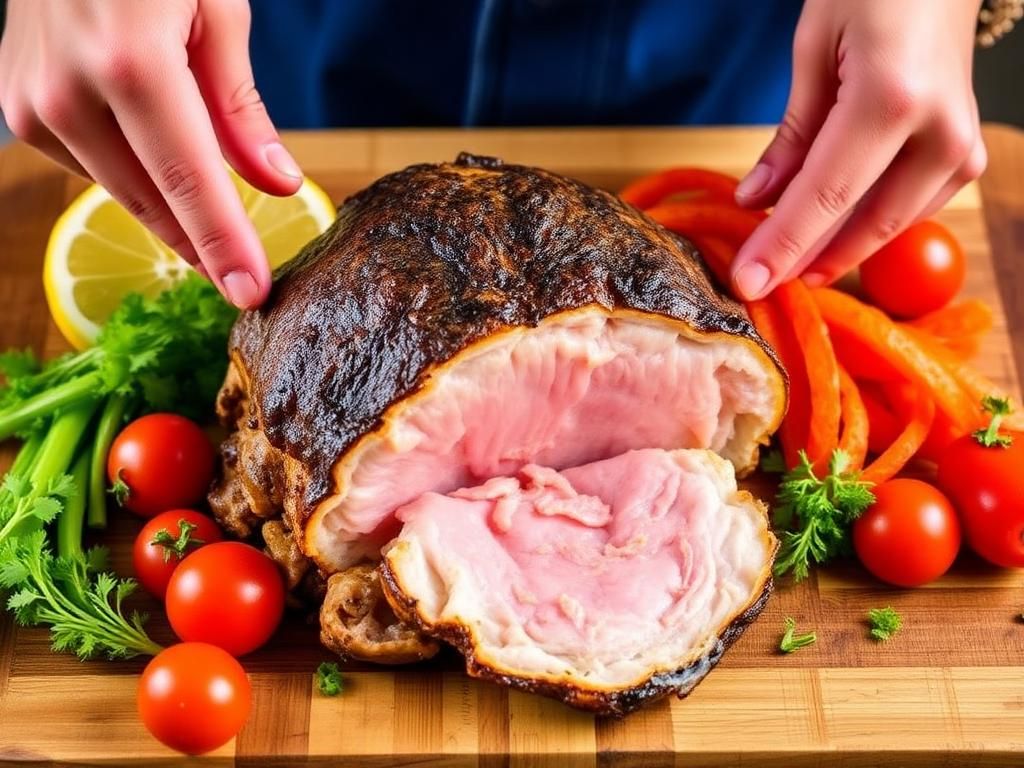Pernil de cerdo, or pork shoulder and leg, is much more than just a dish; it’s a celebration of flavor and tradition that resonates deeply within Latino and Caribbean homes. This tender, savory cut of meat, marinated to perfection and roasted until golden brown, is a staple in festivities, family gatherings, and casual meals alike. Whether you’re intrigued by the cooking techniques or want to learn about its cultural significance, this comprehensive guide explores everything you need to know about pernil de cerdo.
Introduction to Pernil de Cerdo
Definition and Description
Pernil de cerdo refers specifically to the roasted pork shoulder or leg, prized for its rich flavor and juicy texture. This dish is characterized by its crispy exterior and succulent meat, making it an irresistible centerpiece for any meal. In many Latin American countries, pernil de cerdo is synonymous with celebration and family traditions.
Origin and History
The history of pernil de cerdo is deeply intertwined with Latin American culture. Originally, the dish has roots in Spanish cuisine, which evolved over centuries across regions such as Puerto Rico, Cuba, and the Dominican Republic. This culinary favorite often graces tables during significant holidays like Christmas and New Year, where it stands as a symbol of abundance and togetherness. At family gatherings, the aroma of pernil de cerdo roasting evokes nostalgia and creates lasting memories.
Ingredients Needed
Essential Ingredients
To prepare a delicious pernil de cerdo, you’ll need:
- Pork shoulder or leg: This cut offers the right balance of fat and meat for optimal tenderness.
- Marinade components: Common ingredients include garlic, oregano, cumin, and black pepper.
- Citrus fruits: Orange, lime, or lemon juice are often added for brightness and flavor enhancement.
Optional Ingredients
For added complexity in flavor, consider using:
- Additional spices: Bay leaves, paprika, or even chili powder for a hint of heat.
- Aromatics: Chopped onions and bell peppers can enhance the overall dish.
- Varieties of vinegar: White or apple cider vinegar can add tanginess to the marinade.
Preparation Techniques
Marinating the Pork
Marination is crucial when preparing pernil de cerdo. This process allows the flavors to penetrate the meat deeply, resulting in a more flavorful dish. Ideally, marinate the pork for at least 8 hours, though 24 hours is even better for an infusion of flavor.
Cooking Methods
There are various ways to cook pernil de cerdo, including:
- Roasting: This method produces a crispy exterior and juicy interior.
- Slow cooking: Perfect for a tender texture, allowing the flavors to develop gradually.
- Grilling: Ideal for a smoky, charred flavor, particularly popular in outdoor gatherings.
- Other traditional methods: In some cultures, pernil is cooked in an underground oven known as a “bucanera.”
Step-by-Step Cooking Instructions
1. Preparing the Marinade
The marinade is essential for achieving mouthwatering results. For a simple marinade, combine the following ingredients:
- 1 head of garlic, minced
- 1 tablespoon of dried oregano
- 1 tablespoon of ground cumin
- 1/2 cup of orange juice and 1/4 cup of lime juice
- Salt and pepper to taste
Blend these ingredients into a paste for the best flavor infusion.
2. Marinating the Pork
To ensure the pork absorbs the marinade, follow these steps:
- Score the surface of the pork lightly using a sharp knife.
- Rub the marinade generously over the pork, making sure to get it into the scored areas.
- Cover and refrigerate for the suggested time, letting the flavors meld.
3. Cooking the Pernil
Cooking times and temperatures will vary based on the method chosen:
- Roasting: Preheat the oven to 325°F (163°C) and roast for 4-6 hours, until tender.
- Slow cooking: Cook on low for 8-10 hours for the best flavor.
- Grilling: Grill over medium heat for about 2-3 hours, turning occasionally.
Regardless of the method, the internal temperature should reach 200°F (93°C) for perfectly cooked pork. Be sure to let it rest for 20 minutes before slicing!
4. Checking for Doneness
Use a meat thermometer to check doneness, aiming for an internal temperature of at least 195°F (90°C) for pull-apart tenderness. Visually, the meat should be a deep brown color, and the juices should run clear.
Serving Suggestions
Traditional Accompaniments
Pernil de cerdo shines brightest when served with:
- Rice and beans: A classic side that complements the richness.
- Plantains: Whether maduros (sweet) or tostones (savory and crunchy), plantains are a must.
- Side salads or slaws: Fresh salads help balance the meal.
Creative Twists and Modern Takes
For those looking to get creative, consider these modern applications of pernil de cerdo:
- Making sandwiches or sliders with the leftovers for quick meals.
- Using the meat in tacos or burritos for a fusion twist.
- Pairing with unique sauces, like chimichurri or various salsas, to elevate the experience.
Cultural Significance and Festivities
Pernil de Cerdo in Celebrations
Pernil de cerdo takes center stage during many Latino celebrations, particularly around the holidays. It embodies cultural heritage and family values, often prepared with care and passed down through generations. During Christmas and New Year festivities, its presence brings warmth and togetherness, as families gather to enjoy this beloved dish.
Regional Variations
As pernil de cerdo traverses various cultures, it has adapted uniquely in different regions:
- Puerto Rico: Known for its flavorful adobo, often featuring garlic and achiote.
- Cuba: Maintains a similar profile but often incorporates sour orange juice in its marinade.
- Dominican Republic: Sometimes served with a spicy sauce that adds a delightful kick.
Tips for a Perfect Pernil de Cerdo
Common Mistakes to Avoid
To ensure the best outcome when preparing your pernil de cerdo, be mindful of these common pitfalls:
- Under-marinating: A short marination time can lead to bland flavors.
- Over-marinating: Too long can affect the meat’s texture, making it mushy.
- Not letting the meat rest: After cooking, resting is key for juicy results.
Storage and Leftovers
To maximize freshness:
- Store leftovers in an airtight container in the fridge for up to 4 days.
- Freeze for longer-term storage, which allows you to enjoy it later.
- Transform leftover pernil de cerdo into soups, casseroles, or even pizza toppings.
Conclusion
Recap of the Importance of Pernil de Cerdo
In conclusion, pernil de cerdo is more than a meal; it embodies cultural traditions and family connections. The rich flavors and tender texture ensure that it remains a cherished dish across generations.
Call to Action
We invite you to share your experiences with pernil de cerdo or any family recipes in the comments below! Each recipe carries its unique story, and we’d love to hear yours!
References and Additional Resources
Suggested Reading
- Cooking Light – A website with various recipes and tips on Latin American cuisine.
- Food Network – Offers a selection of pernil recipes with different twists.
Acknowledgments
We recognize the diverse cultural contributions and culinary richness that dishes like pernil de cerdo bring to the world of gastronomy.
| Cooking Method | Temperature | Cooking Time | Internal Temp (Final) |
|---|---|---|---|
| Roasting | 325°F (163°C) | 4-6 hours | 195°F (90°C) |
| Slow Cooking | Low | 8-10 hours | 195°F (90°C) |
| Grilling | Medium | 2-3 hours | 195°F (90°C) |
FAQ Section
1. What is the best cut of meat for pernil de cerdo?
The pork shoulder or leg is the best choice for pernil de cerdo due to its fat content, which contributes to flavor and tenderness.
2. How long can I marinate pernil de cerdo?
A marination time of at least 8 hours is recommended, but ideally, 24 hours allows for maximum flavor infusion.
3. Can pernil de cerdo be cooked in an air fryer?
Yes, it is possible to cook pernil de cerdo in an air fryer, adjusting the cooking time and temperature for the best results.
4. What side dishes go well with pernil de cerdo?
Traditional accompaniments include rice and beans, plantains, and fresh salads, enhancing the main dish’s flavors.
5. Is pernil de cerdo gluten-free?
Yes, pernil de cerdo is naturally gluten-free as it’s made from pork and spices.
6. Can I use a different cut of pork?
While pork shoulder or leg is traditional, using pork butt or even ribs can yield delicious results, though the preparation might differ slightly.
7. How do I store leftovers?
Store leftover pernil de cerdo in an airtight container in the refrigerator for up to 4 days or freeze it for longer preservation.
8. What spices are common in a pernil marinade?
Common spices include garlic, oregano, cumin, and sometimes bay leaf or paprika for added flavor.
9. How can I tell if pernil de cerdo is cooked properly?
The best way to check is by using a meat thermometer; aim for an internal temperature of at least 195°F (90°C).
10. What are some creative ways to use leftover pernil de cerdo?
Leftover pernil de cerdo can be used in sandwiches, tacos, casseroles, or added to soups for a flavorful twist.


